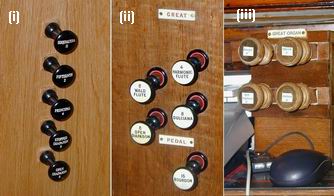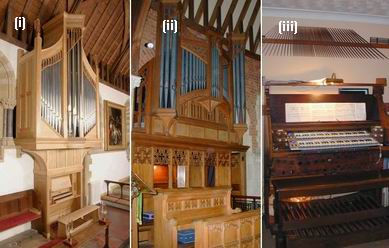Village organs in village churches are a precious part of our English life.
My wife and I play typical village organs, she at St Mary's, Streatley in Oxfordshire
and I (monthly) at nearby St John's, Whitchurch. Both are idyllic villages next to the
river Thames with pristine cherished churches and loyal choirs.
Their organs are of typical village size with 4 or so ranks on Great and Swell manuals,
and a single Bourdon 16' Pedal stop with couplers to Swell and Great. The organ at
Streatley is a gorgeous 3-year-old Robin Jennings
organ of classic style with 5 stops on Great and Swell. Whitchurch has a 1911 Walker Organ with just 4 stops on each side. Both organs have
traditional 'tracker' mechanical action with drawstops. Figure 1 shows the two organs,
and my Prog organ. Their stop lists are shown in the table.
| St Mary's, Streatley | St John's, Whitchurch | My Prog organ |
| Great | 8' Stopped diapason 8 | 8' Dulciana | 8' Dulciana |
| " | 8' Open diapason | 8' Open diapason | 8' Open diapason |
| " | 4' Principal | 4' Harmonic flute | 4' Principal |
| " | 2' Fifteenth | 8' Wald flute | 2' Fifteenth |
| " | Sesquialtera | - | - |
| Swell | 8' Chimney flute | 8' Stopped diapason | 8' Stopped diapason |
| " | 8' Gemshorn | 8' Echo gambia | 8' Geigen diapason |
| " | 4' Flute | 4' Principal | 4'Geigen principal |
| " | 2' Flageolet | 8' Closed horn | Mixture III |
| " | 8' Vox celeste | - | - |
| Pedal | 16' Bourdon | 16' Bourdon | 16' Sub-Bass |
 Figure 2 shows the keyboards of the three organs. All contain the classic Great organ stops:
a soft 8' Dulciana-like sound for quiet moments, an 8' Open Diapason to accompany the hymns,
and a 4' Principal for the louder verses. Streatley has a 2' Fifteenth for brightness
and a Sesquialtera giving a trumpet-like sound. Whitchurch Hill has a sweet Wald flute
just right for quieter accompaniments. The Swell organs are more different but all
have distinctive sounds that contrast well with the Great sounds.
Figure 2 shows the keyboards of the three organs. All contain the classic Great organ stops:
a soft 8' Dulciana-like sound for quiet moments, an 8' Open Diapason to accompany the hymns,
and a 4' Principal for the louder verses. Streatley has a 2' Fifteenth for brightness
and a Sesquialtera giving a trumpet-like sound. Whitchurch Hill has a sweet Wald flute
just right for quieter accompaniments. The Swell organs are more different but all
have distinctive sounds that contrast well with the Great sounds.
This summer I implemented Colin Pykett's Prog organ
into our existing console. This replaced Colin's earlier design based on MIDI keyboard presets.
Our objective was to give us a practice organ as similar as possible to those we had to play.
Listening to the sounds of Colin Pykett's Small Digital Organ (SDO) I selected the
four Great and four Swell stops that I thought would best reproduce the sounds we were used to.
The sounds of all the SDO stops can be heard on my
website.
We had room only for four drawstops on each side of the console if we were to maintain
the big music stand which folds down on top of the keys. This turns the organ into our
family computer, as described in our Magazine #199, October 2006. The stops I chose
are shown in the last column of the table. For the Great the SDO gives us the classic
choices of Dulciana, Diapason, Principal and Fifteenth. For the Swell the objective is
to choose sounds contrasting with the Great. The stopped Diapason and the Geigen Diapason
and Principal give just this effect compared to the Great sounds. Mo and I did argue about
the fourth Swell stop. She loved the fizzy Mixture III. I wanted the distinctive brassy
Cornopean. I gave in as on my organ the drawstops are complemented by an array of 22
push-button stops (from Maplin Electronics) situated beneath the great keyboard.
These define SDO's additional Great and Swell stops, pedal stops, couplers and presets.

Figure 3 shows the Great drawstops of each organ. One of the most tricky skills in
organ playing is to change stops seamlessly, without audible mechanical thuds,
and without false sounds, from keeping your fingers so long on the keys that the
new sound creeps in. You need to practice this just as you need to practice playing the keys.
So my Prog drawstops are designed to work and feel like those of the tracker organs.
The Hall effect drawstops
were made with the kind advice of Ron Coates of
Classic Organs and our Treasurer. The Hall effect uses the bending of moving
electrons under a magnetic field to produce a voltage. The sensor looks like a
tiny transistor, and the magnet is hardly bigger. Sensor and magnet cost a few pounds
only. More details are given in another page of my
website.
Setting them up is a bit tricky because the placing of the magnet near the
sensor needs to be within a few millimetres. But they seem very robust and
once adjusted have given no trouble. The drawstops themselves were made of
square section wood and held in place by a square wooden lattice at front
and back as shown in figure 3. The lattice was easily made from a gorgeous
piece of teak panelling which happened to be in my workshop.
The apertures are lined with thin leathers to give just the right friction
to the drawstop. Once adjusted, the drawstops are very easy and quick to operate.
I have been delighted with the results! Combinations of the eight drawstops
alone give a truly enormous variety of sounds and are appropriate for essentially
all the music I play. Moving registration ideas from Prog organ to Streatley and
to Whitchurch organs has proved an easy task.
If village organs tend to stay the same, village organists are changing.
I remember when we came to the area 35 years ago hearing dazzling voluntaries
in our local churches. Most organists were highly experienced. Now it is different.
The organists I had listenened to have retired. They have been replaced, well by
people like me pianists without a single organ lesson, who have taught themselves
by their ears, and in my case from an ancient copy of Stainer's excellent 1909
Novello's primer The Organ . Some organists have not been replaced.
Some, as at Whitchuch, have been replaced by a monthly rota. There are 16 organist
vacancies on the Berkshire Organists' Association website. We must work to keep the
sounds of our village organs alive. Prog organ is important, as without it to
practice on, I should never have dared play in church.
Copyright 2008 Colin Windsor : Last updated 15/1/2008
 Figure 2 shows the keyboards of the three organs. All contain the classic Great organ stops:
a soft 8' Dulciana-like sound for quiet moments, an 8' Open Diapason to accompany the hymns,
and a 4' Principal for the louder verses. Streatley has a 2' Fifteenth for brightness
and a Sesquialtera giving a trumpet-like sound. Whitchurch Hill has a sweet Wald flute
just right for quieter accompaniments. The Swell organs are more different but all
have distinctive sounds that contrast well with the Great sounds.
Figure 2 shows the keyboards of the three organs. All contain the classic Great organ stops:
a soft 8' Dulciana-like sound for quiet moments, an 8' Open Diapason to accompany the hymns,
and a 4' Principal for the louder verses. Streatley has a 2' Fifteenth for brightness
and a Sesquialtera giving a trumpet-like sound. Whitchurch Hill has a sweet Wald flute
just right for quieter accompaniments. The Swell organs are more different but all
have distinctive sounds that contrast well with the Great sounds.
 An Article published by the Electronic Organ Magazine in 2008
An Article published by the Electronic Organ Magazine in 2008

